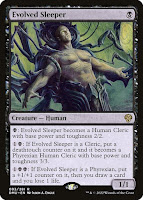It's rotation month! Well, almost. On 1 August, the four oldest Magic sets will rotate out of Standard (I explain the concept here). As is my custom, I look at these 'expiring' sets in turn and reflect on their attributes, positives, and negatives. Today: Dominaria United.
Released in September 2022, Dominaria United (DMU) was another return to the Dominaria plane (the location for most of the original Magic expansions). And it kicked off the 30th anniversary of the game; as such, it focused on paying homage to the game's past while also looking to the future.
The mechanics in this set included:
- kicker, a longstanding favorite. Pay an extra cost upon casting to gain an extra effect.
- domain, an ability that grew more powerful based on the different basic lands you controlled, encouraging multi-colored strategies
- enlist, a clunky ability [in my opinion] that allowed you to tap another creature you controlled to add to an attacking creature's power
- stun counters, a cool ability with the following effect: "(If a permanent with a stun counter would become untapped, remove one from it instead.)"
The theme in this set revolved around legendary creatures. As a nod to the past, many of Magic's most (in)famous charcters showed up in this set. An astonishing 49 cards—out of 281 in the base set—are legendary. It also had 20 "Legends Retold" cards, focusing on old favorites (from the original Legends set) in 'new skins,' so to speak. Finally, you had a small chance of getting a card from the original Legends set, as Wizards found a pallet of the old cards from 1994 [seriously; read about that here] and randomly inserted them in packs. I got this one in a pack; it's worth nothing, but was still fun to pull:
DMU had two preconstructed Commander decks—one based on legendary creatures, and the other based on the domain concept [having all 5 basic lands for maximum benefit].
Favorites
I love tribal decks, and DMU had some nice cards for soldiers (Resolute Reinforcements, Valiant Veteran), goblins (Rundveldt Hordemaster, Squee), and elves (Leaf-Crowned Visionary). Leyline Binding is an auto-include in any domain deck. Jodah, the Unifier, was fun to build around (both in Standard and Commander). I had a fun blue deck that featured Haughty Djinn, Tolarian Terror, and a ton of cheap instants/sorceries to make them powerful (or cheap to cast). Aether Channeler has three nice ETB abilities. Cut Down is a key black spell. Evolved Sleeper had nice buff and card draw abilities. And Defiler of Vigor could make things go crazy in a 'stompy' deck. Finally, DMU had ten common lands with two basic land types (Wooded Ridgeline below is representative). That was cool.
Good Riddance
I had a hard time picking cards here, as nothing truly stood out as always annoying. But there were a few that could needle me: Cult Conscript generally heralded some sort of recursive graveyard engine that (generally) made for long games. Liliana was often annoying. Sheoldred was so powerful; fun to play and annoying to play against. And Ivy was a pesky faerie that featured in combo decks I found bothersome.
In sum, I really enjoyed this set; I like both legendary creatures and the domain concept. I didn't care for the enlist ability, but everything else was fun.




























































